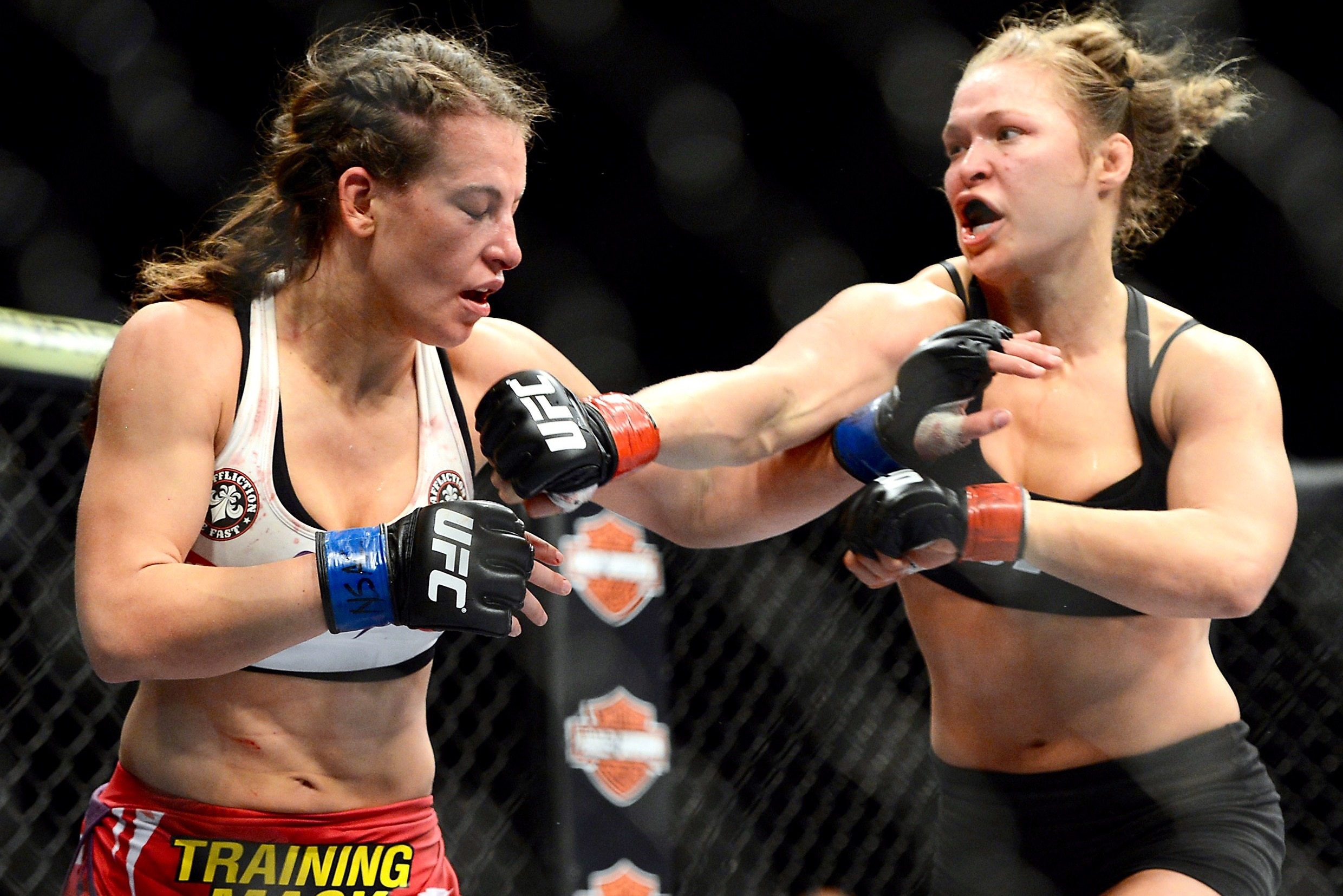Miesha Tate vs. Ronda Rousey 3: Proof UFC Has a Women's MMA Problem
July 27, 2015
Miesha Tate (17-5) was supposed to be a finished product. Now in her eighth year as a professional, the book on the 28-year-old Tate had been written long ago—good grappler, enthusiastic but awful striker. In the still-developing world of women's MMA, it was enough to make her a perennial contender.
Last Saturday against Jessica Eye, however, Tate took a match to the book and lit it aflame, several shockingly powerful overhand rights announcing to the world that a new Miesha Tate was being constructed at Xtreme Couture in Las Vegas.
"I felt like first 30 seconds, I had to adjust. I sat into my striking and turned my takedowns into an overhand right. I’m going to need that against Ronda," Tate told Fox Sports 1's Karen Bryant after the fight. "I finally showed that I have power in my hands. I’m doing things to make me better. I have some of the best grappling in the division, and now I have power in my striking."
The unanimous-decision win, Tate's fourth in a row, was enough to earn a third opportunity against The Queen of MMA Ronda Rousey.
"She’s fought her way back to Ronda," UFC President Dana White said to Bryant after the bout. "Jessica was shredding her in the first round and she walked through her and made it a fight. She looked awesome. I’m in awe how tough she is."
It was a huge victory for Tate—and the sign of monumental problems for the sport of women's MMA. As the most dominant champion in the sport, Rousey is expected to run through an overmatched Bethe Correia at UFC 190 on Saturday, much as she's run through Tate twice in 2012 and 2013, respectively.
A rubber match is a beautiful thing when two fighters have split their previous bouts. But when one fighter has wiped the floor with the other on two separate occasions? Then it becomes a difficult proposition to sell to an increasingly sophisticated and discerning fanbase.
The sad truth is that despite a lack of interest in a Tate-versus-Rousey trilogy, it's the best women's bantamweight fight the UFC has to offer—and a problem it's created for itself by all but ignoring women's MMA. The UFC, for all the progress made and the courage shown bringing women into the fold, still doesn't seem fully committed to the experiment.
The promotion, quite obviously, is fully invested in the Ronda Rousey business. Women's MMA, generally, hasn't gotten the same love. According to Bleacher Report's research, fewer than 10 percent of all UFC fights so far in 2015 have featured women, making both women's bantamweight and the new strawweight division the least active divisions in the sport.
| Fights By Weight Class | ||
| Weight Class | Numer of Fights | Percentage of Total Fights |
| Heavyweight | 16 | 5.4 |
| Light Heavyweight | 14 | 4.8 |
| Middleweight | 37 | 12.5 |
| Welterweight | 58 | 19.7 |
| Lightweight | 63 | 21.3 |
| Featherweight | 37 | 12.5 |
| Bantamweight | 21 | 7.1 |
| Women's Bantamweight | 14 | 4.8 |
| Flyweight | 22 | 7.5 |
| Women's Strawweight | 13 | 4.4 |
| sherdog.com | ||
Grand total, there have been 14 fights in the bantamweight division and just 27 women's bouts overall. If all weight classes were given equal time, that number would shoot up to 59 women's fights. Worse, more than 40 percent of those fights have appeared on UFC's Fight Pass in front of a comparatively small audience of mostly hardcore fans willing to pay $9.99 a month for a collection of classic bouts and opening matches from each card.
The UFC simply doesn't treat male fighters this way. The heavyweights, though often relegated to the undercard, are featured in the main or co-main event regularly, six times this year alone. Only the similarly disrespected flyweight and bantamweight classes can compare. Like the women, those weight classes are also having a hard time building stars. The problem, as shown here, has less to do with the fighters than it does with the institution—it's systemic, whether by design or not.
| Weight Classes Most Likely to be on the Undercard | |
| Weight Class | Percentage of Fights on Undercard |
| Flyweight | 77 |
| Bantamweight | 66.6 |
| Women's Bantamweight | 57 |
| sherdog.com | |
This is no way to build a sport. The UFC has a once-in-a-lifetime talent in Rousey. It's done an amazing job nurturing her abilities and building her brand. But somewhere along the way, it forgot that no one gets into the cage alone. Rousey needs a dancing partner to continue to create her legend—and the UFC is failing her by letting the bantamweight division fall to pieces around her.
Want to find the next Rousey? She won't be the woman flailing away on Fight Pass or sitting at home waiting for a call. She'll be the athlete fans have watched all along, promoted up and down the card in compelling bouts. For that to happen, the UFC has to book more women's fights. Nine cards this year, in fact, didn't include a single fight between women.
That has to change.
Inserting women into the UFC instead of side-draining them into a separate-but-equal promotion of their own was a stroke of genius. Now it's time for White and the UFC to reap the rewards of its own bravery.
